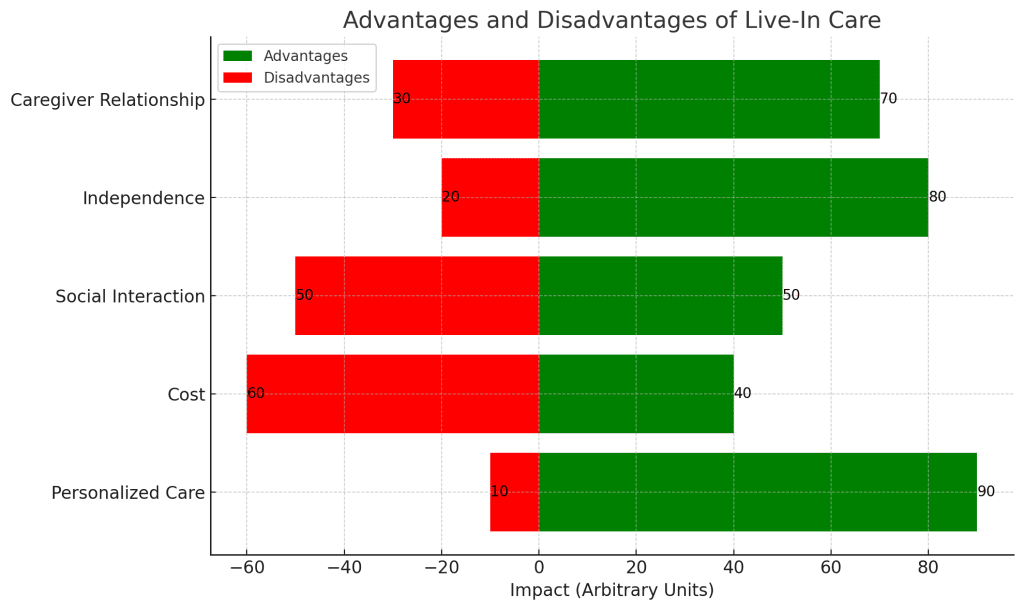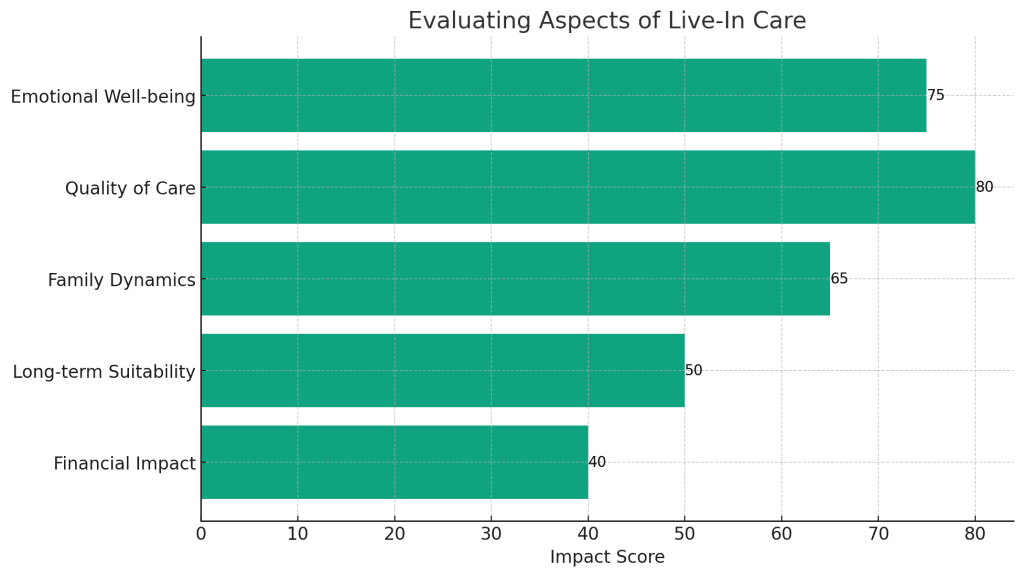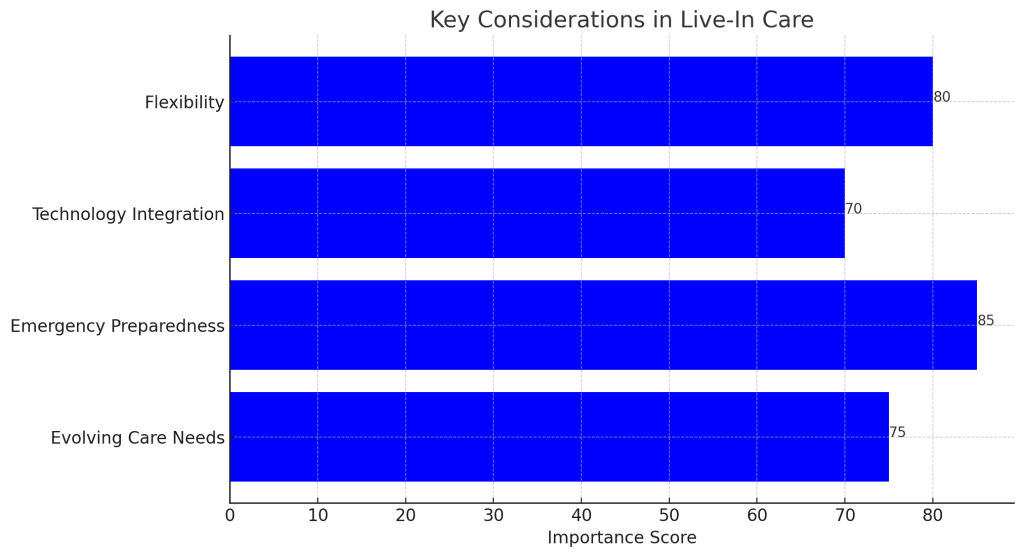Understanding Live-In Care
Live-in care involves having a professional caregiver live in your home to provide care and support on a full-time basis. This option can be particularly appealing for those who wish to stay in their own homes while receiving the necessary care. It offers a personalized approach, as the care is tailored to the individual’s specific needs and routines.
Advantages of Live-In Care
- Personalized and Consistent Care: One of the primary advantages of live-in care is the level of personalized attention and consistency in care. The caregiver gets to know the individual’s preferences, routines, and specific care needs intimately.
- Comfort of Home: Staying in familiar surroundings can be particularly beneficial for individuals with dementia or those who value the comfort and familiarity of their own home.
- Maintaining Independence: Live-in care allows individuals to maintain a level of independence, making their own choices about their daily routines and lifestyle.
- Family Peace of Mind: Knowing that a loved one is receiving constant, professional care can offer significant peace of mind to family members.
Disadvantages of Live-In Care
- Cost: Live-in care can be expensive, as it involves paying for a professional to be available around the clock. It’s important to compare these costs with other care options.
- Limited Social Interaction: Unlike a care home setting where there are opportunities to socialize with other residents, live-in care might limit social interactions to primarily the caregiver.
- Space and Privacy Concerns: Having a caregiver living in the home may raise issues of space and privacy for some individuals.
- Dependence on One Caregiver: Relying on a single caregiver can be a risk if the caregiver falls ill or needs time off.
Comparing Live-In Care with Residential Care Homes
When considering live-in care, it’s important to compare it with other options like residential care homes. Residential care homes offer a community setting, regular social activities, and often have a range of care services available. The choice between live-in care and a residential care home will depend on individual preferences, care needs, and financial considerations.

Navigating Emotional and Psychological Aspects
The emotional and psychological aspects of live-in care are significant. For the care recipient, having a caregiver in their home can offer a sense of security and companionship, reducing feelings of loneliness and isolation. However, it may also pose challenges in terms of adapting to having someone else in their personal space and the potential loss of some privacy.
Professional and Quality Care Standards
Ensuring the quality and professionalism of the caregiver is crucial in live-in care. Families should conduct thorough background checks, verify qualifications, and ensure the caregiver is a good fit for their loved one’s personality and needs. It’s also important to have clear communication and agreements on care expectations and boundaries.
Impact on Family Dynamics
Live-in care can also affect family dynamics. While it can alleviate the burden of care from family members, it can also change the family’s routine and interactions. Open communication and setting clear expectations can help in managing these changes effectively.
Long-term Considerations
When opting for live-in care, it’s important to consider long-term implications. As the care needs of the individual evolve, so might the requirements from the caregiver. There may come a time when the level of care needed surpasses what can be provided in a home setting, necessitating a transition to a more specialised care facility.
Conclusion
Deciding whether to opt for live-in care involves weighing various factors, including personal preferences, care needs, financial implications, and the potential impact on family dynamics and personal space. It’s a decision that requires careful consideration and often, the input of healthcare professionals. Comparing live-in care with other options like residential care homes is crucial to make an informed decision that best suits the individual’s needs and circumstances.

Flexibility and Personal Space in Live-In Care
One of the unique advantages of live-in care is the flexibility it offers. Unlike in a care home where schedules are often fixed, live-in care can adapt to the personal routines and preferences of the individual. However, this flexibility must be balanced with respect for the personal space and privacy of both the individual receiving care and the caregiver. Setting boundaries and maintaining open communication are key to ensuring a harmonious living arrangement.
Technology and Live-In Care
The integration of technology in live-in care can significantly enhance the quality of care and the overall experience for both the caregiver and the care recipient. From medical alert systems to telehealth services, technology can provide additional safety nets and facilitate efficient communication with healthcare professionals and family members.
Emergency Preparedness in Live-In Care
Emergency preparedness is a critical aspect of live-in care. Families should ensure that live-in caregivers are trained to handle emergencies and are familiar with the specific health needs of the care recipient. This includes knowing how to respond in a medical emergency, understanding the individual’s medication regimen, and having access to important health information.
Continuous Evaluation of Care Needs
The needs of an individual receiving live-in care can change over time. Regular assessments and adjustments to the care plan are essential to ensure that the care provided continues to meet the evolving needs of the individual. This might involve additional training for the caregiver, incorporating new care strategies, or even considering alternative care options if necessary.
Conclusion
Live-in care offers a personalized, flexible care option for those wishing to stay in their own homes. While it presents many advantages, including tailored care and the comfort of familiar surroundings, it also comes with challenges such as cost considerations and potential limitations in social interactions. Weighing these factors against personal preferences and care needs is crucial in making an informed decision. Families should also consider the evolving nature of care needs and be prepared to adapt as required.

Key Takeaways
| Key Point | Description |
|---|---|
| Personalized Care | Advantages of receiving tailored care in a familiar environment. |
| Cost Comparison | Comparing the costs of live-in care with traditional care home options. |
| Social Interaction | Assessing the impact on social life and community engagement. |
| Flexibility and Independence | The benefits and challenges of maintaining independence at home. |
| Caregiver Relationship | The dynamics of forming a close relationship with a live-in caregiver. |

